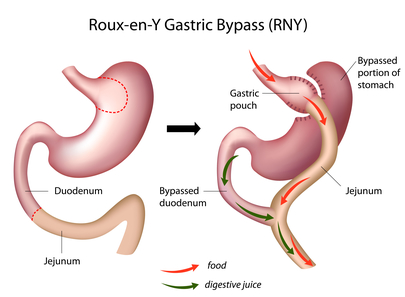Bariatric Conversion – Bariatric Surgery in Mexico
About Bariatric Conversion

Bariatric medicine is defined as a branch of medicine that deals with the cause, treatment of and prevention of obesity. This includes performing surgery on the stomach and/or intestines for weight loss purposes: if these organs can be reduced in size, the amount of nutrients can therefore be restricted causing a drop in weight. However, bariatric surgery is only done on persons with a body mass index (BMI) of forty and higher who are at risk from health problems such as diabetes and heart diseases.
Types of Bariatric Surgery
At least six types of weight loss procedures fall under the gross heading of bariatric surgery. They are gastric bypass (Roux-en-Y), duodenal switch, vertical sleeve gastrectomy, adjustable gastric banding (lap band), bariatric conversion surgery, and multi-step operations. These procedures can be further categorized as restrictive of malabsorptive techniques, depending on their effect on the body.
Bariatric conversion surgery and weight loss operations have become the number one clinical method for fighting obesity in North America. Their popularity can be attributed to the perceived ease of the operations and to their seemingly logical approach to weight loss. Some operations, while successful, may need tuning up from time to time (revision surgeries) while others may cause added complications in their recipients. It is important to understand the Pros and Cons of each type of weight loss surgery, consult with Dr Castaneda to assess your individual case.
Pros and Cons of Bariatric Surgery
The advantages to these procedures are obvious: lowered risks of heart disease and obesity, a smaller body mass index, increased mobility and improvement of self-worth. Patients also claim improved quality of life even many years after the surgery has been performed.
The cons, on the other hand, may not be obvious until one has actually had the surgery. Complications mainly occur from not following the prescribed rules given by the surgeon prior to having the surgery and from the surgeries themselves. The most common associated problems are listed below:
Pulmonary Embolism
The second greatest risk is that of pulmonary embolism. A pulmonary embolism is a blood clot that ordinarily occurs in the leg and travels up the bloodstream where it can become lodged in the lungs and block the flow. If any part of the body is denied blood, be it cell, tissue or organ, that part slowly begins to suffocate and starve.
Gastro-Intestinal Tract Leak, Strictures and Bowel Obstruction
These are all caused by healing or adjusting of organs after surgery. With the gastro-intestinal leaks, the contents of the bowels may backwash into the stomach causing infections, illness, fever, pain and shortness of breath.
Strictures are stomach obstructions caused by scar tissue. As the incision heals, the tissue comes together and hardens and thickens into a scar. Sometimes the scar is thick and big enough to block the passages altogether, preventing the patient from absorbing nutrients either through eating or drinking.
Bowel obstruction is a stricture that occurs in the bowel or abdominal area. This blocks the bowel movements and can have severe effects on one’s health.
Advantages and Problems According to Procedure
It is important to note that the rates of failure for these procedures are actually very low. Most procedures only claim a one to two percent failure rate. In fact these procedures have a very advanced success rate and only fail in very particular cases.
Laparascopic Adjustable Gastric Band (Lap-band)
The Lap-band has the highest failure rate of all procedures. Many patients who had received lap-bands were beset by complications such as band erosion, leakage and slippage. Furthermore, more than forty five percent of patients had not lost weight despite having the bands for more than ten years. The Lap-band was touted as a success in its early years due to a lack of data on its true performance.
Laparascopic Roux-en-Y Gastric ByPass
This procedure tends to have an overall positive effect on its patients. The Roux-en-Y procedure tended to have the highest rates of weight loss and ideal weight maintenance with over sixty five percent of patients losing weight and keeping their weight down. Very few nutritional problems are encountered, and those that are can be maintained by taking supplements. There is little need for revisional surgery for this type of method; however it does have a fifteen percent failure rate.
Duodenal Switch
This surgery prevents the absorption of nutrients by introducing a barrier, of sorts. The barrier’s main flaw is that it tends to restrict most food absorption and has a very high chance of failure due to its complicated nature. Duodenal Switch surgery is usually accompanied by long term nutrient deficiency and protein and fat malabsorption.
Vertical Sleeve Gastrectomy
This is a relatively new procedure which shares the same results as the Roux-en-Y Gastric ByPass in that it is dependable and has low rates of failure. However, since this procedure is fairly new, there is little data to support this claim.
Conclusion on Bariatric Conversion Surgery
Bariatric surgeries are definitely the best recourse for those seeking to reverse obesity, however this technique should only be a last resort. The trend of obesity is caused mainly by learned habits which include poor nutrition and lack of exercise. It is possible to address the problem by reverting to healthy lifestyle, whether or not surgery has been performed.





